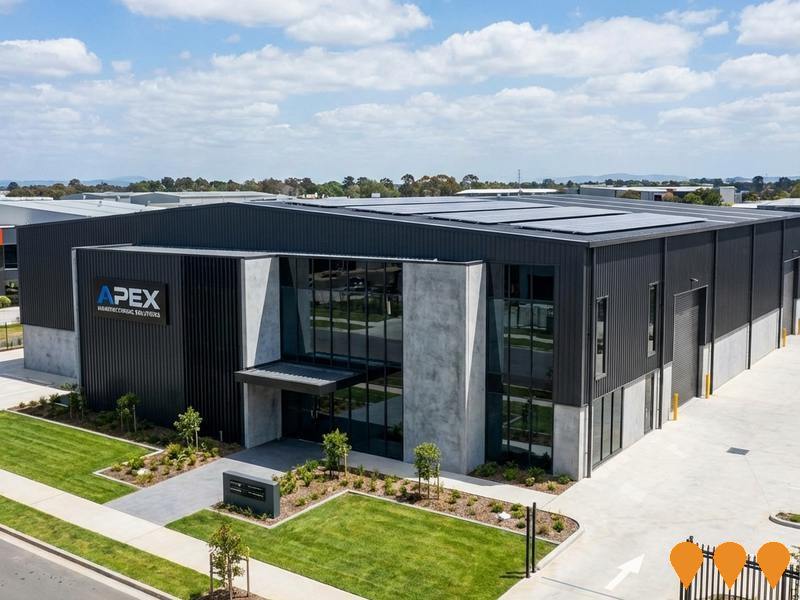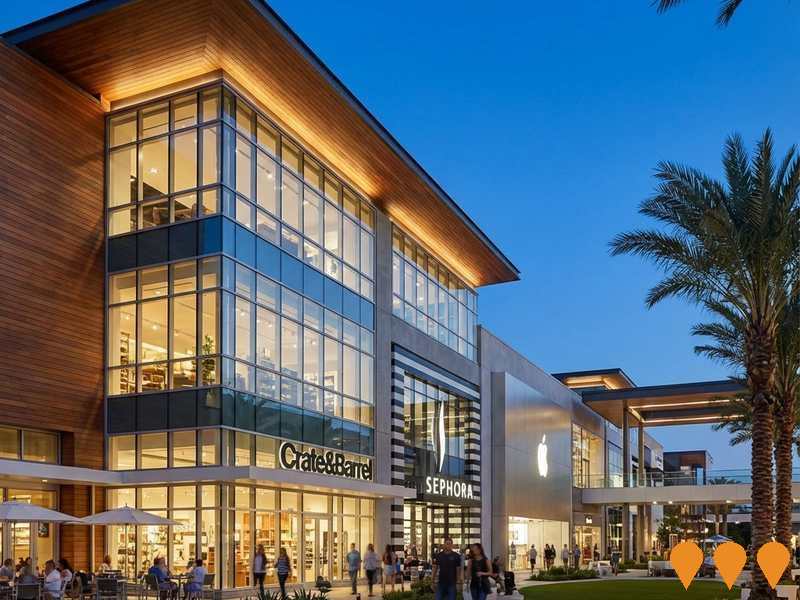Chart Color Schemes
est. as @ -- *
ABS ERP | -- people | --
2021 Census | -- people
Sales Activity
Curious about local property values? Filter the chart to assess the volume and appreciation (including resales) trends and regional comparisons, or scroll to the map below view this information at an individual property level.
Find a Recent Sale
Sales Detail
Population
An assessment of population growth drivers in Quoiba - Spreyton reveals an overall ranking slightly below national averages considering recent, and medium term trends
Quoiba - Spreyton's population is approximately 3,296 as of August 2025. This figure represents an increase of 180 people since the 2021 Census, which reported a population of 3,116. The growth was inferred from ABS estimates of 3,281 in June 2024 and an additional 76 validated new addresses since the Census date. The population density is around 115 persons per square kilometer. Quoiba - Spreyton's growth rate of 5.8% since the 2021 census surpassed both the SA4 region (4.5%) and the state average, indicating it as a growth leader in the region. Natural growth contributed approximately 40.5% of overall population gains during recent periods, with all drivers including interstate migration and overseas migration being positive factors.
AreaSearch uses ABS/Geoscience Australia projections for each SA2 area, released in 2024 with a base year of 2022. For areas not covered by this data, Tasmania State Government's Regional/LGA projections released in 2022 with a base year of 2021 are adopted and adjusted using a method of weighted aggregation of population growth from LGA to SA2 levels. Future population projections anticipate lower quartile growth for national regional areas, with the area expected to expand by 53 persons to 2041 based on the latest population numbers, resulting in an increase of approximately 1.1% over the 17 years.
Frequently Asked Questions - Population
Development
AreaSearch analysis of residential development drivers sees Quoiba - Spreyton recording a relatively average level of approval activity when compared to local markets analysed countrywide
Quoiba-Spreyton has seen approximately 21 new homes approved annually. Over the past five financial years, from FY21 to FY25, around 109 homes were approved, with an additional seven approved in FY26. On average, about 1.8 people moved to the area each year for every dwelling built during these five years.
This suggests a balanced supply and demand dynamic. The average construction cost value of new homes was $351,000, aligning with regional trends. In FY26, commercial approvals totaled $6.3 million, reflecting the area's residential character.
Compared to the Rest of Tasmania, Quoiba-Spreyton has seen slightly more development, with 16.0% above the regional average per person over the five-year period. This balance supports buyer choice while maintaining current property values. However, recent periods have shown a moderation in development activity. The new developments consist predominantly of detached houses (93.0%) and a smaller portion of medium to high-density housing (7.0%), preserving the area's traditional low-density character with a focus on family homes. With around 218 people per approval, Quoiba-Spreyton reflects a low-density area. Future projections indicate an increase of approximately 38 residents by 2041. At current development rates, new housing supply should comfortably meet demand, providing favorable conditions for buyers and potentially supporting population growth beyond current projections.
Frequently Asked Questions - Development
Infrastructure
Quoiba - Spreyton has limited levels of nearby infrastructure activity, ranking in the 11thth percentile nationally
Changes in local infrastructure significantly affect an area's performance. AreaSearch has identified seven projects that could impact the region. Notable ones are Don Irrigation Scheme, Devonport Oval Sports Complex, North West Support School Devonport, and Devonport to Cradle Mountain Corridor - Planning. The following list details those most relevant.
Professional plan users can use the search below to filter and access additional projects.
INFRASTRUCTURE SEARCH
 Denotes AI-based impression for illustrative purposes only, not to be taken as definitive under any circumstances. Please follow links and conduct other investigations from the project's source for actual imagery. Developers and project owners wishing us to use original imagery please Contact Us and we will do so.
Denotes AI-based impression for illustrative purposes only, not to be taken as definitive under any circumstances. Please follow links and conduct other investigations from the project's source for actual imagery. Developers and project owners wishing us to use original imagery please Contact Us and we will do so.
Frequently Asked Questions - Infrastructure
North West Hospitals Masterplan - Mersey Community Hospital
Comprehensive 20-year masterplan for Mersey Community Hospital as part of the $1.4 billion North West Hospitals Masterplan. Includes new sub-acute building for medical oncology services, new inpatient unit for geriatric evaluation and management, and expansion of specialist services. The $45 million Outpatients and Theatres redevelopment was completed in May 2025, delivering a new Elective Day Surgery Centre with 13 new consulting rooms, 6 specialist treatment rooms, 5 dedicated pediatric rooms, new audiology services and physiotherapy gym. Stage 1 of the broader masterplan includes further expansions with completion targeted for 2030.

Devonport Mental Health Hub
A new $40 million purpose-built mental health facility for Tasmania's North West region. The hub includes a Safe Haven for people experiencing suicidal or situational distress, a Recovery College offering free peer-led education, and an Integration Hub providing brief interventions and navigation support. Construction commenced in early 2025 and the facility is on track for completion in late 2027.
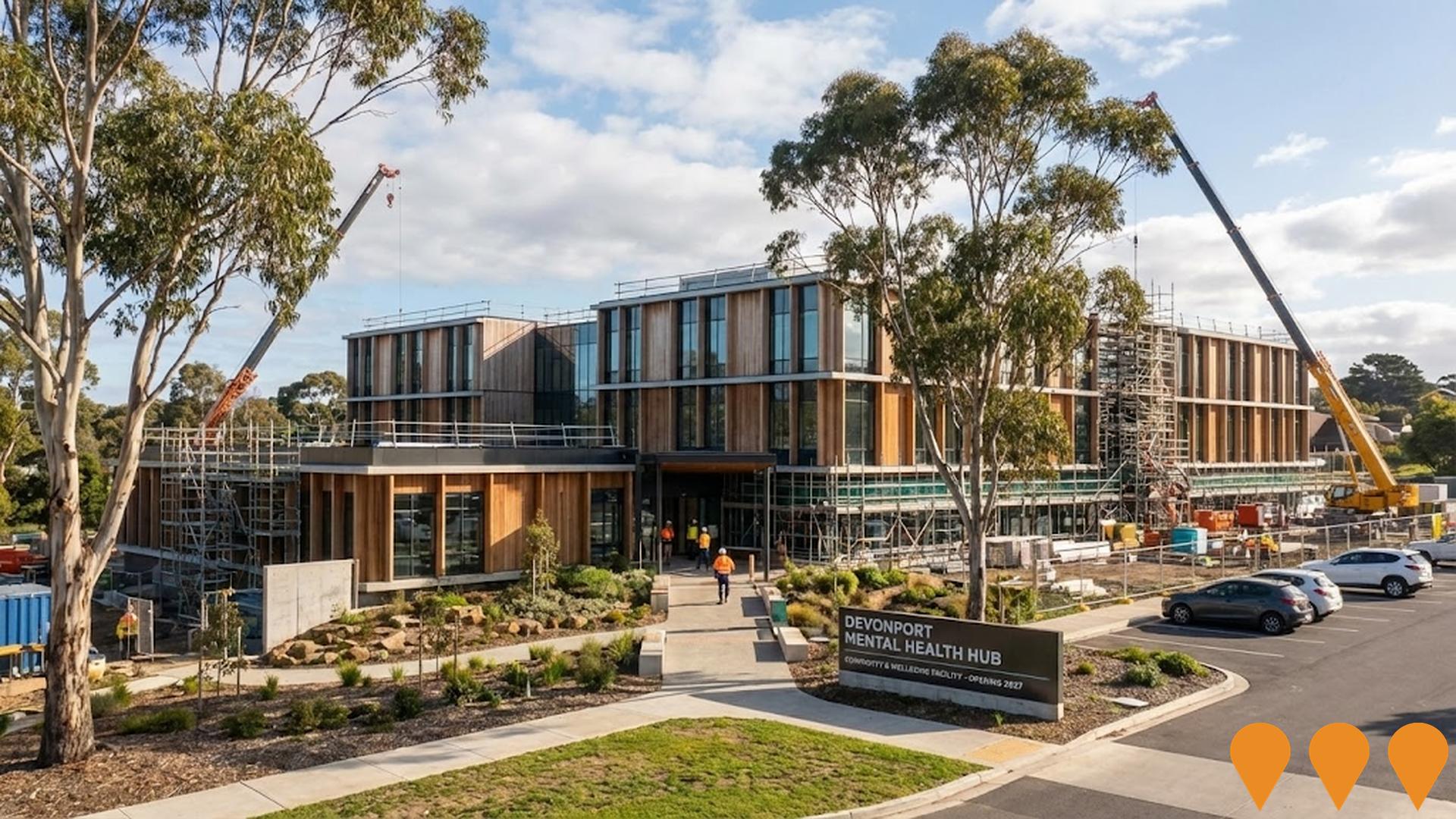
Hydrogen Devonport Project
A 5 MW PEM electrolyser facility at Wesley Vale (near Devonport) producing up to 690 tonnes of green hydrogen per year using renewable hydro and wind power. The plant will supply heavy transport, industrial users and power generation, forming a key part of Tasmania's Hydrogen HyWay#1 ecosystem. Construction commenced in late 2025 with first hydrogen production expected in 2026.

Latrobe Flood Levees Project
Award-winning flood protection system comprising 1.5km of earth and concrete levees (1-3m high), large box culvert diversion structure, pumps, gates and infrastructure to protect Latrobe's CBD and residential areas from Mersey River and Kings Creek flooding. The innovative project redirects flood flows from Kings Creek through underground channels beneath Gilbert Street and Cotton Street. Main construction completed mid-2023 with final works ongoing. Winner of Engineers Australia Excellence Award 2024 Project of the Year Tasmania and Civil Contractors Federation Earth Awards.
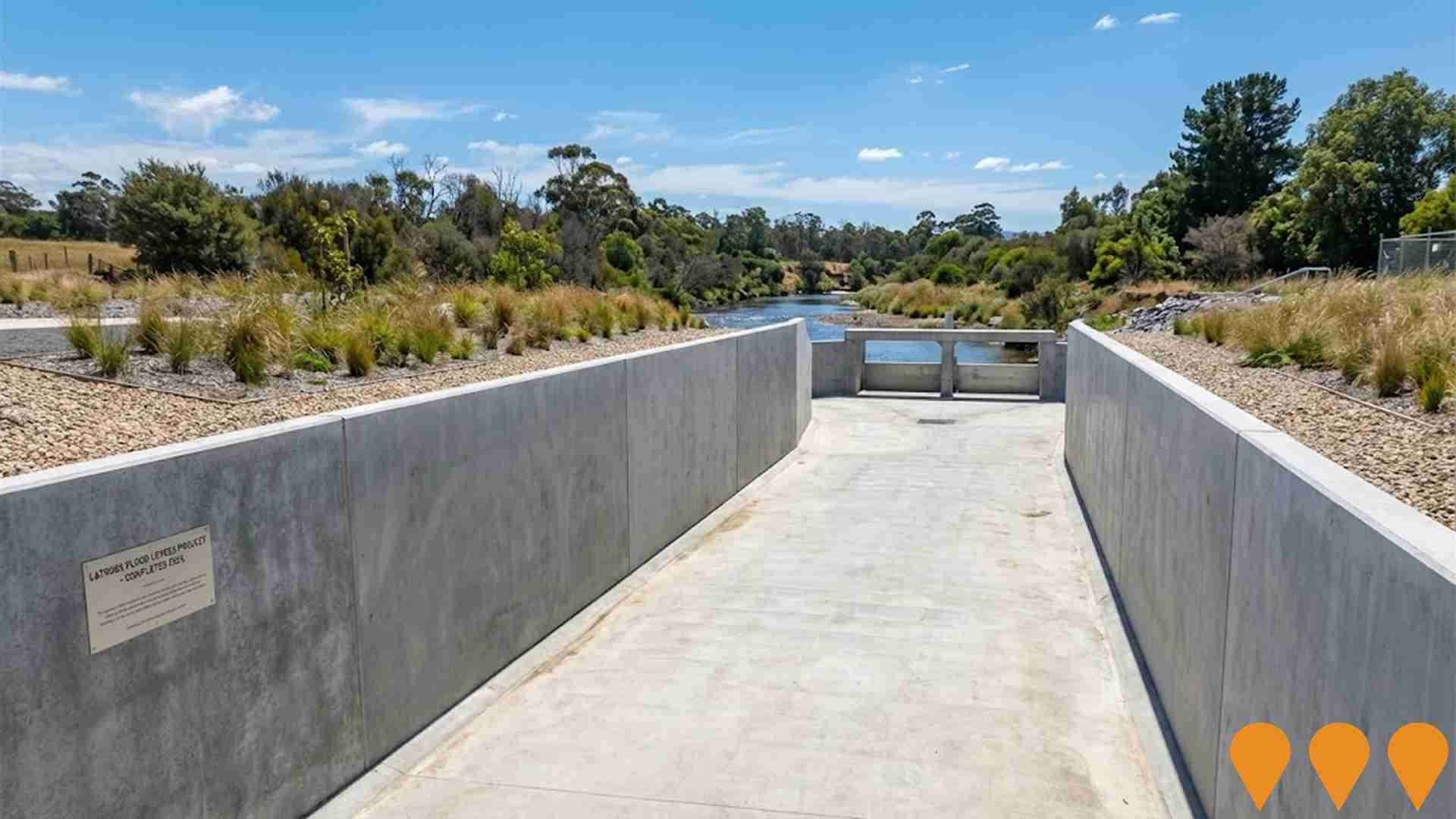
Devonport Oval Sports Complex
Six-court indoor sports venue with five outdoor courts, serving at least six major sporting codes. Includes shared social facilities, administration facilities, and high-performance training areas. Contractor: Fairbrother Pty Ltd.
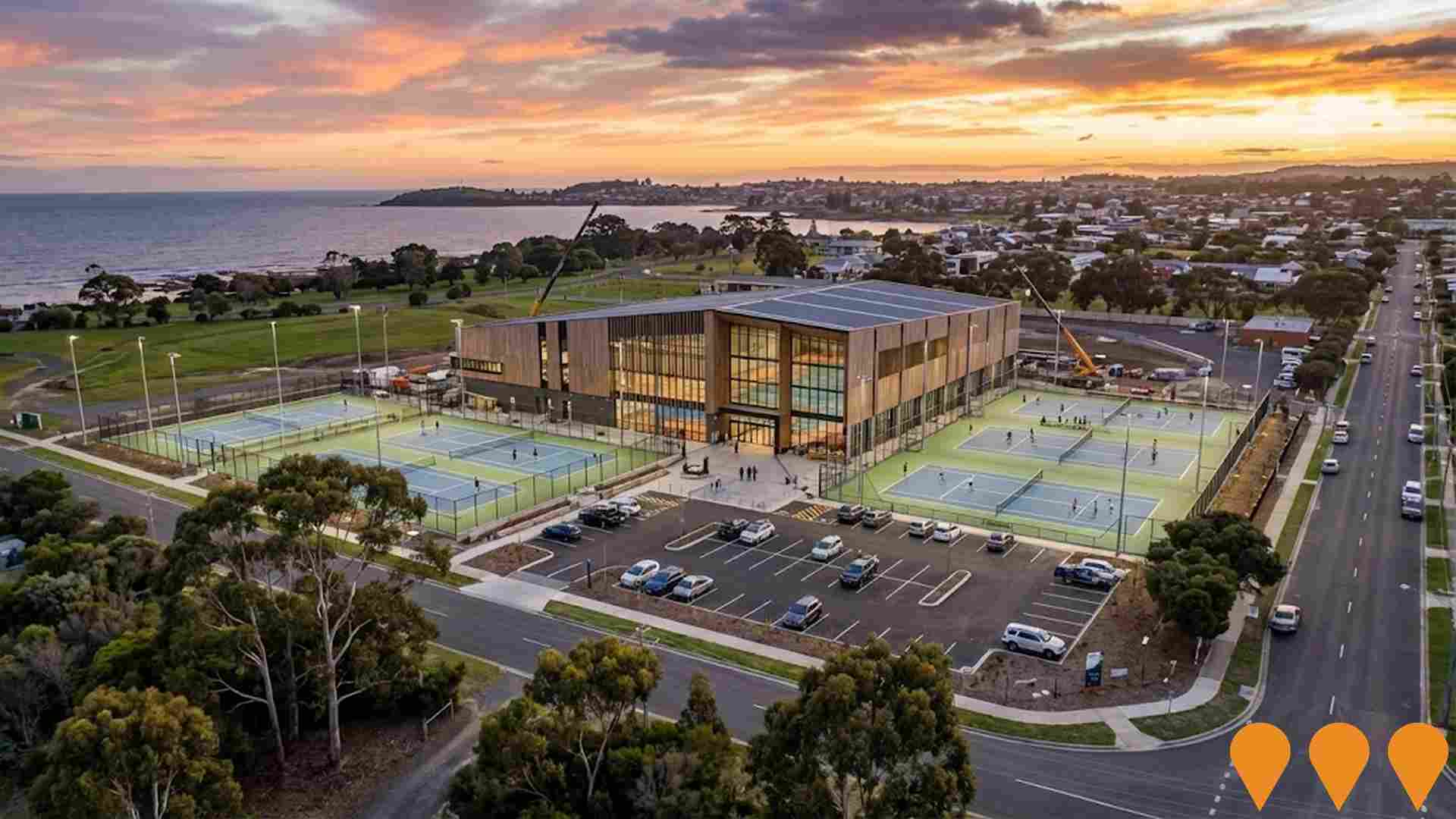
Sassafras Wesley Vale Irrigation Scheme Augmentation
Augmentation of the existing Sassafras Wesley Vale Irrigation Scheme to deliver an additional 9.2 gigalitres of high-surety irrigation water annually. The project includes installation and refurbishment of approximately 102 km of pipeline, upgrade of the Great Bend Pump Station, construction of the Saggers Hill Balance Tank, Sassafras Booster Pump Station, and replacement of property outlets. The scheme will increase total capacity from 5,660 ML to 14,860 ML per year, serving 132 irrigators across approximately 18,000 hectares of agricultural land in northwest Tasmania. Water is sourced from the Mersey River with backup supply from Parangana Dam.

Don Irrigation Scheme
53km pipeline network with 3 pump stations delivering 4,750 megalitres of irrigation water annually. Serves Don, Forth, Barrington and Sheffield districts. Expected to generate 48 ongoing jobs and $100 million annual economic benefit.

Don to Leith Coastal Pathway
110km cycle pathway linking towns and cities from Latrobe to Wynyard, connecting more than 85,000 residents. Devonport to Latrobe section complete, Devonport to Ulverstone under construction. Part of regional infrastructure initiative.

Employment
The employment environment in Quoiba - Spreyton shows above-average strength when compared nationally
Quoiba - Spreyton has a diverse workforce with both white and blue collar jobs. The manufacturing and industrial sectors are prominent.
As of June 2025, the unemployment rate is 2.7%. In the past year, employment grew by an estimated 2.2%. There are 1,739 residents in work, with an unemployment rate of 1.2% below Rest of Tas.'s rate of 3.9%. Workforce participation stands at 63.2%, higher than Rest of Tas.'s 55.7%.
Key employment sectors include health care & social assistance, construction, and retail trade. Construction is particularly specialized, with an employment share 1.3 times the regional level. However, agriculture, forestry & fishing is under-represented at 4.6% compared to Rest of Tas.'s 8.4%. The worker-to-resident ratio is 0.6, indicating above-average local employment opportunities. Over a 12-month period ending June 2025, employment and labour force both increased by 2.2%, keeping unemployment steady. This contrasts with Rest of Tas., where employment contracted by 0.5% and unemployment fell marginally. National employment forecasts from Jobs and Skills Australia (May 2025) project a 6.6% increase over five years and 13.7% over ten years. Applying these projections to Quoiba - Spreyton's employment mix suggests local growth of approximately 5.9% over five years and 12.7% over ten years, though these are simple extrapolations for illustrative purposes only.
Frequently Asked Questions - Employment
Income
Income levels align closely with national averages, indicating typical economic conditions for Australian communities according to AreaSearch analysis
AreaSearch's aggregation of ATO data shows Quoiba - Spreyton had a median taxpayer income of $56,440 and an average of $66,608 in financial year 2022. Nationally, the averages were $57,384 and $47,358 respectively for Rest of Tas. By September 2025, estimates suggest median income would be approximately $64,246 and average $75,820, based on a 13.83% Wage Price Index growth since financial year 2022. Census figures from 2021 rank Quoiba - Spreyton incomes modestly, between the 37th and 41st percentiles for household, family, and personal incomes. Income analysis reveals that 34.4% of individuals (1,133 people) earn between $1,500 and $2,999, similar to the regional pattern where 28.5% fall into this band. Housing costs allow for retention of 88.7%, but disposable income is below average at the 43rd percentile.
Frequently Asked Questions - Income
Housing
Quoiba - Spreyton is characterized by a predominantly suburban housing profile, with above-average rates of outright home ownership
Dwelling structure in Quoiba - Spreyton, as per the latest Census, consisted of 97.8% houses and 2.2% other dwellings (semi-detached, apartments, 'other' dwellings). In comparison, Non-Metro Tas.'s dwelling structure was 90.3% houses and 9.7% other dwellings. Home ownership in Quoiba - Spreyton was at 41.2%, with the rest of dwellings either mortgaged (44.6%) or rented (14.1%). The median monthly mortgage repayment in the area was $1,300, aligning with Non-Metro Tas.'s average. The median weekly rent figure was recorded at $275, compared to Non-Metro Tas.'s $250. Nationally, Quoiba - Spreyton's mortgage repayments were lower than the Australian average of $1,863, while rents were substantially below the national figure of $375.
Frequently Asked Questions - Housing
Household Composition
Quoiba - Spreyton has a typical household mix, with a higher-than-average median household size
Family households constitute 76.5% of all households, including 28.7% couples with children, 35.0% couples without children, and 10.9% single parent families. Non-family households account for the remaining 23.5%, with lone person households making up 22.5% and group households comprising 1.8%. The median household size is 2.5 people, larger than the Rest of Tas. average of 2.3.
Frequently Asked Questions - Households
Local Schools & Education
Quoiba - Spreyton faces educational challenges, with performance metrics placing it in the bottom quartile of areas assessed nationally
The area's university qualification rate is 13.9%, significantly lower than the Australian average of 30.4%. This presents both a challenge and an opportunity for targeted educational initiatives. Bachelor degrees are most common at 10.5%, followed by postgraduate qualifications (1.8%) and graduate diplomas (1.6%). Vocational credentials are prominent, with 45.0% of residents aged 15+ holding such qualifications - advanced diplomas at 8.8% and certificates at 36.2%.
A substantial 23.9% of the population is actively pursuing formal education, including 10.1% in primary, 7.3% in secondary, and 2.1% in tertiary education. Spreyton Primary School serves Quoiba - Spreyton, with an enrollment of 317 students as of a certain date. The area offers varied educational conditions, with one school focusing exclusively on primary education and secondary options available nearby. School places per 100 residents (9.6) are below the regional average (14.1), indicating some students may attend schools in adjacent areas.
Frequently Asked Questions - Education
Schools Detail
Nearby Services & Amenities
Transport
No public transport data available for this catchment area.
Frequently Asked Questions - Transport
Transport Stops Detail
Health
Health performance in Quoiba - Spreyton is lower than average with common health conditions somewhat prevalent across both younger and older age cohorts
Spreyton, part of the Quoiba statistical area, faces notable health issues. Common health conditions are prevalent across various age groups, with private health cover at approximately 52% (~1727 people), higher than Rest of Tas' 48.3%.
Arthritis and mental health issues are prevalent, affecting 11.2% and 8.7% respectively. Around 64.7% report no medical ailments, compared to Rest of Tas' 61.1%. The area has 23.2% (764 people) aged 65 and over, lower than Rest of Tas' 25.4%. Health outcomes among seniors align with general population's profile.
Frequently Asked Questions - Health
Cultural Diversity
The latest Census data sees Quoiba - Spreyton placing among the least culturally diverse areas in the country when compared across a range of language and cultural background related metrics
Quoiba-Spreyton had below average cultural diversity, with 91.6% of its population born in Australia, 94.1% being citizens, and 97.3% speaking English only at home. Christianity was the predominant religion, comprising 38.0% of people in Quoiba-Spreyton. Buddhism had a slightly higher representation compared to Rest of Tas., with 0.9% vs 0.8%.
The top three ancestral groups were Australian (35.8%), English (35.2%), and Scottish (7.0%). Notably, Australian Aboriginal was overrepresented at 4.8%, Welsh at 0.6%, and Dutch at 1.3%.
Frequently Asked Questions - Diversity
Age
Quoiba - Spreyton hosts an older demographic, ranking in the top quartile nationwide
Quoiba-Spreyton has a median age of 43 years, which is slightly below Rest of Tas.'s 45 but considerably higher than Australia's average of 38. Comparing with Rest of Tas., Quoiba-Spreyton has a notably higher proportion of the 45-54 age group (13.2% locally) and a lower proportion of those aged 85+ (1.7%). Between 2021 and present, the population share of the 75-84 age group increased from 6.3% to 8.1%, while the 35-44 cohort rose from 11.2% to 12.6%. Conversely, the 5-14 age group decreased from 12.2% to 10.3%, and the 25-34 group fell from 12.7% to 11.3%. By 2041, demographic projections suggest significant changes in Quoiba-Spreyton's age profile. The number of people aged 85+ is expected to surge by 97 (an increase of 175%) from 55 to 153. Notably, the combined 65+ age groups are projected to account for 80% of total population growth, reflecting the area's aging demographic trend. In contrast, population declines are projected for the 5-14 and 0-4 age cohorts.
